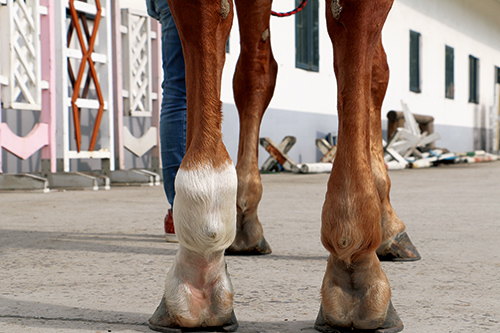Hey there—I’ve been meaning to share how I approach diagnosing tendon injuries in horses. If you’ve ever watched a horse limping or seen swelling along the lower leg and wondered, “What’s going on in there?”, I totally get it. Tendon injuries in horses can be tricky—super subtle sometimes, and other times obvious as heck. Let’s dig in, chat-style, so it feels more like two horse lovers comparing notes over coffee.

Why tendon injuries matter—and why they sneak up on us
Horses’ tendons—especially the superficial digital flexor tendon (SDFT) and the deep digital flexor tendon (DDFT)—take a ton of wear. From cantering on uneven ground to jumping fences or sprinting, those tendon fibers bear considerable stress. When things go sideways—micro-tears, fiber misalignment, or full tears—you get inflammation and lameness. But early on, the horse might trot around just fine. That’s why I always keep an eagle eye on irregularities.
What I listen for: signs you can’t ignore
We chat about training progress and performance markers. If suddenly your horse is “not quite right”—maybe a slight limp, a bit guarded when putting weight on the leg, or warmth at the back of the cannon bone—those are early red flags. I also pay attention to subtle asymmetry in gait or a change in the way the horse lands heel-first or toe-first. Those little clues sometimes speak volumes.
Hands-on check: feeling the tendons (ultrasound later)
My first move is always a careful palpation. I run my fingers gently along the length of the SDFT and DDFT. If there’s a thickened area, a fluid-filled swelling, or if the horse shows any sensitivity when I press, that speaks volumes. Then I compare between legs—often, what feels fine on the “good” leg helps me spot mild changes on the suspect one. No high-tech gear yet—just careful, hands-on detective work.
Here’s a simple breakdown of what to check:
| Check | What to look for |
|---|---|
| Palpation | Thickening, heat, pain response |
| Flexion test | Increased lameness upon flexing fetlock |
| Observation in motion | Guarded stride, heel-first strike changes |
| Swelling comparison | Asymmetry between legs |
This little chart helps me keep things clear when explaining things to owners—“See, here’s what I’m checking.”
Ultrasound time—seeing what’s underneath the surface
Once the manual check hints at something, I pull out the ultrasound probe—veterinary-grade, portable, handy. Nothing fancy like MRI in most barns. I use it to view cross-sections of the tendon. That lets me see fiber pattern, any core lesions, areas of hemorrhage, or fiber disruption. Scans in longitudinal (lengthwise) and transverse (cross-wise) planes help me assess damage extent.
I’ll chat with the owner: “Look here, do you see that dark area? That’s where fibers aren’t echoing back properly—likely a lesion.” We discuss how big that spot is, because size correlates with healing time. The bigger the lesion, the longer it’s going to take. And I always remind folks—don’t compare to that plastic-fantastic healing time you heard about online; real horses heal at their own pace.

Grading tendon injuries—how bad is it?
I tend to use a grading scale (0 đến 4):
-
Grade 0: No visible lesion, maybe very mild fiber disruption.
-
Grade 1: Minimal fiber disruption, mild swelling.
-
Grade 2: Clear core lesion, moderate enlargement of tendon.
-
Grade 3: Large lesion, obvious tendon thickening.
-
Grade 4: Severe changes, risk of recurrent tearing.
If the scan shows changes under 10% of cross-sectional area, that’s a mild Grade 1; if it’s 50%+, much more serious. We talk recovery plans and prognosis accordingly.
What I tell owners: recovery isn’t quick—but doable
I keep it real: proper healing takes months. Tendons like slow, controlled rehab—not rush. My typical process:
-
Initial rest phase (weeks 0–6): Strict stall rest, hand-walking only.
-
Controlled loading (weeks 7–12): Gradually increase hand-walking, introduce short trot.
-
Moderate exercise (weeks 13–20): Turnout or round-pen walking, building load carefully.
-
Full return (after week 20): Depending on injury grade, begin canter work and normal regimen.
Ultrasound check-ins at about 6, 12, và 20 weeks let us see how the tendon fills in. Communication with trainers or riders helps keep expectations realistic and ensures the horse doesn’t go from 0–100 too fast.
A few sideline tips I picked up from colleagues abroad
Chatting with vets from the UK or US, I’ve picked up things like using therapeutic ultrasound or shockwave therapy as adjuncts—not magic bullets, but helpful for increasing blood flow and stimulating healing. Some prefer using medical-grade tendon support boots during turnout or early rehab—not to push, but to offer support.
Some folks experiment with PRP (platelet-rich plasma) injections—there’s mixed evidence. It might help, but only when combined with proper rehab. And I absolutely don’t let folks skip re-checking with ultrasound before full return.
Looking ahead—preventing repeats
Once healed, I always talk prevention. I suggest:
-
Regular hoof trimming and shoeing—imbalanced weight makes tendons overcompensate.
-
Thoughtful work plan—warm-up, cool-down, varying footing, avoiding deep sand or super hard surfaces.
-
Watch body condition—too much weight = over-strain.
-
Incorporate cross-training (like hill work or swimming) to build tendon resilience.
Wrapping up
Diagnosis is detective work and talking. I combine feeling, visual exam, real-time ultrasound, and a chatty, transparent approach with owners. Tendon injuries aren’t career-enders—they’re challenges you meet with patience, planning, and good communication.
Let me know if you want to dig deeper into rehab exercises or case studies sometime. Always happy to yak about horses.